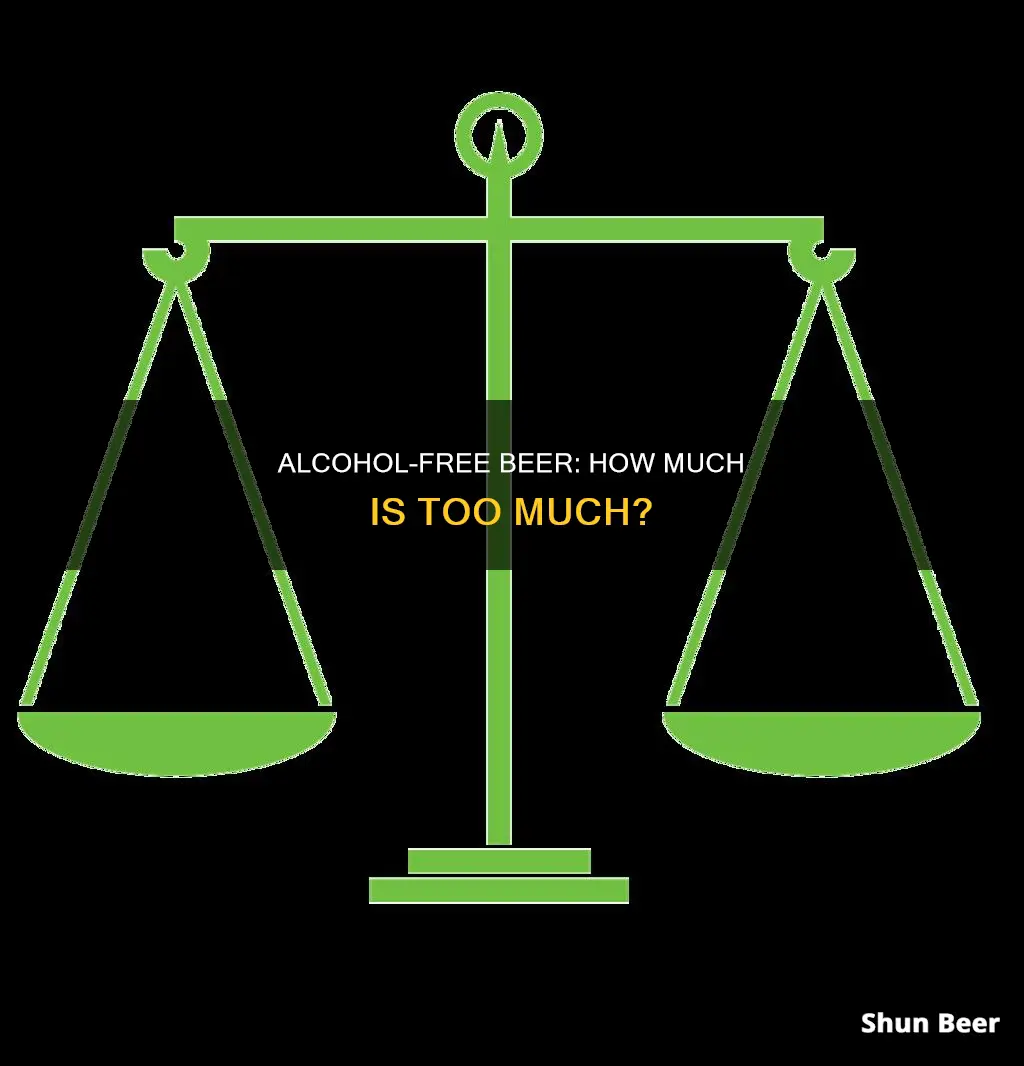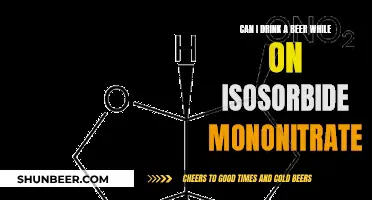
Alcohol-free beer is often presented as a safe alternative to alcoholic drinks, but it's important to be aware of the risks before trying it. While it's almost impossible to get drunk on alcohol-free beer, it's worth noting that it may still contain small amounts of alcohol. In the United States, beverages containing less than 0.5% alcohol by volume (ABV) can be labelled as non-alcoholic. Similarly, in the United Kingdom, drinks with an ABV of up to 0.5% can be labelled as alcohol-free, while those between 0.05% and 0.5% are described as dealcoholised.
The amount of alcohol in alcohol-free beer is typically very small, with about 0.2g of alcohol in a pint of 0.05% beer and 2.2g in a pint of 0.5% beer. This is comparable to the amount of alcohol found naturally in some everyday foods and drinks, such as ripe bananas, orange juice, and burger rolls.
While alcohol-free beer may be a suitable option for some individuals, it's important to consider potential risks. For pregnant individuals or those trying to conceive, it's recommended to avoid alcohol-free beer due to the potential presence of unsafe alcohol levels. Additionally, for those recovering from alcohol use disorder, the taste and smell of beer may act as a trigger.
Ultimately, the decision to consume alcohol-free beer depends on individual preferences and circumstances. It's essential to be aware of the potential presence of alcohol and make an informed choice based on one's health and wellbeing.
How much alcohol-free beer can I drink?
| Characteristics | Values |
|---|---|
| Maximum alcohol by volume (ABV) | 0.5% |
| Typical ABV | 0.05% to 0.5% |
| Number of alcohol-free beers to equal one regular beer | 10 |
| Number of alcohol-free beers to get drunk | Impossible for a healthy adult |
| Number of alcohol-free beers to equal the drink-driving limit in England | 14 |
| Number of alcohol-free beers to equal the drink-driving limit in Scotland | 9 |
| Number of alcohol-free beers to feel the minor effects of alcohol | 20 |
| Number of alcohol-free beers to equal the alcohol in a large glass of orange juice | 2 |
| Number of alcohol-free beers to equal the alcohol in a ripe banana | 1 |
What You'll Learn

Alcohol-free beer and driving
Alcohol-free beer typically contains up to 0.5% alcohol by volume (ABV). While it is not possible to get drunk on these beverages, it is important to understand how they can impact your ability to drive.
In the UK, the legal limit for driving under the influence is defined as having a blood alcohol concentration (BAC) of more than 0.08%. This limit is uniform across all 50 states in the US as well. However, it is important to note that you can still be charged with drink driving even if your BAC is below this limit, depending on your behaviour on the road. The penalties for drink driving can include a driving ban, fines, and even imprisonment.
When it comes to alcohol-free beer, the amount you can consume without exceeding the legal limit will depend on various factors, including your weight, metabolic rate, and gender. For example, a 180-lb man may be able to drink up to 3.5 regular 12-ounce beers in an hour and maintain a BAC under the legal limit, while a 140-lb woman may be able to consume up to 2.5 beers in the same timeframe. These estimates assume that the average beer has a 5% ABV.
It is important to note that these numbers are just estimates, and individual tolerance levels can vary. Additionally, craft beers with a higher ABV will contain a significantly higher amount of alcohol, so it is crucial to be mindful of the specific drink you are consuming.
While alcohol-free beers are generally safe to consume before driving, it is always best to err on the side of caution. If you plan to drive, consider opting for non-alcoholic or alcohol-free alternatives to ensure your safety and compliance with the law.
Beer and Gym: Drinking After a Workout, Good or Bad?
You may want to see also

The amount of alcohol in alcohol-free beer
Alcohol-free beer typically contains up to 0.5% alcohol by volume (ABV). However, the amount of alcohol in alcohol-free beer can vary depending on the country and specific regulations. In the United States, for example, beverages containing less than 0.5% ABV can be labelled as "non-alcoholic". Similarly, in many other countries, beers with up to 0.5% ABV can be marketed as "alcohol-free" or "non-alcoholic".
On the other hand, the legislation in the United Kingdom differentiates between "alcohol-free" and "de-alcoholised" beverages. According to UK law, "alcohol-free" drinks are allowed to have a maximum of 0.05% ABV, while beverages with an ABV between 0.05% and 0.5% are labelled as "de-alcoholised". This distinction highlights the UK's stricter approach to labelling and the recognition that even small amounts of alcohol can have an impact.
It is important to note that the alcohol content in alcohol-free beer is significantly lower than in regular beer, which typically has an alcohol content of around 5% ABV. The low alcohol content in alcohol-free beer means that it is almost impossible for your blood alcohol content to reach levels that would cause intoxication or impairment. In fact, your body processes the alcohol in a low-ABV beer at a faster rate than you can drink it, preventing any accumulation of alcohol in the body.
While alcohol-free beer does contain trace amounts of alcohol, it is important to understand that it is not completely alcohol-free. This distinction is crucial, especially for individuals with alcohol use disorders, pregnant individuals, or those trying to become pregnant. The presence of alcohol, even in small quantities, can trigger cravings and increase the risk of relapse for those in recovery.
Additionally, it is worth noting that alcohol is naturally present in many everyday foods and drinks, such as ripe bananas, orange juice, and burger rolls, sometimes in higher quantities than in alcohol-free beer. Therefore, consuming these foods and beverages can also contribute to overall alcohol intake, especially for those aiming to avoid alcohol completely.
In conclusion, while alcohol-free beer may contain up to 0.5% ABV, the specific regulations and labelling vary across different countries. The low alcohol content in these beverages means that intoxication or impairment is highly unlikely. However, it is important to be aware of the presence of alcohol, especially for individuals with specific health concerns or those aiming for complete abstinence from alcohol.
Beer Consumption and Rheumatoid Arthritis: Exploring the Link
You may want to see also

The effects of alcohol-free beer
Alcohol-free beer is often presented as a safe alternative to alcoholic drinks, but it is important to be aware of the risks before consuming it. While it is a good option for people looking to reduce their alcohol intake, it is also essential to consider the potential risks.
Firstly, it is important to note that alcohol-free beer is not completely free of alcohol. In the United States, beverages containing less than 0.5 percent alcohol by volume (ABV) can be labelled as "non-alcoholic". Similarly, in the United Kingdom, drinks with an ABV of up to 0.5% can be labelled as "alcohol-free", while those between 0.05% and 0.5% are described as "de-alcoholised". This means that a pint of 0.5% beer can contain about 2.2 grams of alcohol. However, it is worth noting that even foods like ripe bananas, orange juice, and burger rolls can contain similar or higher amounts of alcohol.
Despite the low alcohol content, there are certain risks associated with alcohol-free beer. For individuals with alcohol use problems, the smell and taste of these beverages, which are similar to regular beer, can trigger cravings and a subsequent relapse. Additionally, for pregnant individuals, alcohol-free beer may still pose risks as it may contain small amounts of alcohol. According to the American College of Obstetrics and Gynecology (ACOG), pregnant individuals should avoid any alcohol consumption to prevent fetal alcohol spectrum disorder (FASD).
On the other hand, alcohol-free beer can be a viable option for those looking to reduce their alcohol intake without completely eliminating the taste and experience of drinking beer. The body processes the alcohol in low-alcohol beer very quickly, making it almost impossible to get drunk. For example, the average person's body will process the alcohol in a pint of 0.5% beer in around 16 minutes, compared to almost three hours for a pint of 5% beer.
In conclusion, while alcohol-free beer does contain small amounts of alcohol, it is important to note that similar amounts of alcohol are present in some everyday foods and drinks. The potential risks of alcohol-free beer should be considered, especially for pregnant individuals and those with alcohol use disorders. However, for those looking to reduce their alcohol intake, it can be a viable option, as it is very unlikely to cause intoxication. Ultimately, the decision to consume alcohol-free beer depends on individual preferences and circumstances.
Beer and Weight Loss: Is There a Link?
You may want to see also

The safety of alcohol-free beer
Alcohol-free beer is often presented as a safe alternative to regular beer. While it may be a good option for some, it's important to be aware of the potential risks associated with it, especially for certain groups of people. Here's an overview of the safety considerations when it comes to alcohol-free beer:
Alcohol Content
Firstly, it's important to understand that "alcohol-free" beer doesn't always mean it contains zero alcohol. In many countries, including the United States, beers with less than 0.5% alcohol by volume (ABV) can be labelled as "non-alcoholic" or "alcohol-free." This means that these beverages may still contain small amounts of alcohol. UK legislation is stricter, allowing "alcohol-free" beers to have up to 0.05% ABV, while those between 0.05% and 0.5% ABV are labelled as "de-alcoholised."
Health Risks
The amount of alcohol in alcohol-free beer is typically very small and won't get you drunk. However, it's important to note that for certain individuals, even these small amounts can pose health risks. For example, research suggests that people with liver impairments may experience higher blood alcohol levels after consuming alcohol-free beer. Additionally, for pregnant individuals, it's generally recommended to avoid any alcohol consumption to prevent fetal alcohol spectrum disorder (FASD).
Triggers for Alcoholics
Alcohol-free beer can be a trigger for individuals recovering from alcoholism. The smell and taste of beer may induce cravings and increase the risk of relapse. As such, it is generally advised that individuals in recovery avoid alcohol-free beer and anything that resembles alcohol.
Driving and Alcohol-Free Beer
Alcohol-free beer won't impair your ability to drive. The alcohol content is negligible, and it's processed by the body quickly. However, it's important to note that if you're planning on driving, it's always best to err on the side of caution and not consume too much of any substance that could affect your alertness or coordination.
Nutritional Considerations
Alcohol-free beer typically has a higher carbohydrate content than regular beer due to the addition of sugars and flavourings. Therefore, it's important to be mindful of this, especially if you're monitoring your carbohydrate intake for health or dietary reasons.
In conclusion, while alcohol-free beer may be a suitable option for some individuals, it's important to be aware of the potential risks and considerations. It's always a good idea to check labels, understand the ingredients, and make an informed decision based on your personal circumstances.
Japan's Beer Culture: A Historical Perspective
You may want to see also

Alcohol-free beer alternatives
While non-alcoholic beer is often presented as a safe alternative to alcoholic drinks, it may not be the best option for certain individuals. For instance, non-alcoholic beer may be unsafe for pregnant people or those with alcohol use problems.
If you are looking for alternatives to alcoholic and non-alcoholic beer, there are several options to consider. These include:
- Soda with fresh lime juice
- Soda with fresh fruit
- Coffee (be mindful of your caffeine intake, though!)
- Mocktails, such as:
- Mockscow Mule by Mocktails
- Sparkling lemon lime by Betty Buzz
- Punchy blood orange, bitters and cardamom by Ocado
- Pre-mixed cocktails by Highball, including:
- Classic G&T
- Pink G&T
- Cosmopolitan
- Italian Spritz
- Mojito
- Ginger Dram
- Non-alcoholic spirits, such as:
- Tanqueray's 0% gin alternative
- Sea buckthorn by Bax Botanics
- Caleño's rum alternative
- Amaretto by Archers
- Blanco tequila alternative by Clean Co
- Herbal non-alcoholic spirit by Seedlip
- Non-alcoholic wines, such as:
- Thomson & Scott's 'Noughty'
- Oddbird's sparkling rosé
- La Gioiosa's Italian alcohol-free sparkling wine
- Giesen's New Zealand alcohol-removed wines
- Non-alcoholic cider, such as Magners Alcohol Free Cider
- Non-alcoholic cocktails, such as: Twisst Caramel Cream (Baileys alternative)
- Non-alcoholic beer, such as:
- IMPOSSIBREW®’s Enhanced Lager and Pale Ale
- Lucky Saint
- Adnams' alcohol-free pale ale
- Harvey's Old Ale
- Lervig 'No Worries' IPA
- Big Drop Brewing Co.'s Galactic milk stout
If you are looking to cut back on your drinking, it is also helpful to make lifestyle changes that support sobriety and long-term recovery. This can include eating a balanced diet, engaging in regular physical activity, getting enough sleep, participating in hobbies and leisure activities, finding ways to deal with triggers, and utilizing stress management techniques.
Beer Before Workout: Good or Bad Idea?
You may want to see also
Frequently asked questions
Alcohol-free beer typically contains up to 0.5% ABV (alcohol by volume). You can drink alcohol-free beer and drive without fear of getting in trouble or impairing your ability to drive. However, it's important to note that you can still be charged with drink driving if your behaviour on the road suggests impairment, even if your blood alcohol concentration is within the legal limit.
Alcohol-free beer may still contain small amounts of alcohol, so it's generally recommended to avoid it during pregnancy. The American College of Obstetrics and Gynecology (ACOG) advises pregnant individuals to abstain from consuming any alcohol to eliminate the risk of fetal alcohol spectrum disorder (FASD).
The smell and taste of alcohol-free beer may trigger cravings and a subsequent relapse for people in recovery from alcohol use disorder. If you're in recovery and concerned about potential triggers, it's best to avoid alcohol-free beer and opt for non-alcoholic beverages that don't resemble alcoholic drinks in taste or appearance.







